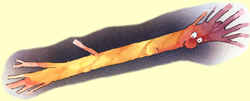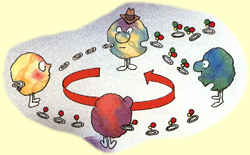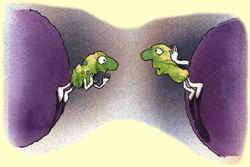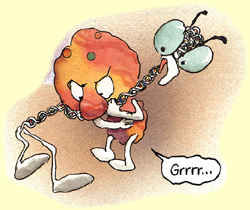 |
 |
 |
Enzymes Enzymes are catalysts - they speed up the breaking apart and putting together of molecules. Their surfaces have special shapes that "recognize" specific molecules, similar to the way a lock accepts only a certain key. Enzymes themselves remain unchanged by the changes they bring about; so they can be used over and over again. |
Transporters |
 |
 |
Movers Because the shape of protein chains is mostly determined by weak, easily broken and remade chemical bonds, these chains can shorten, lengthen, and change shape in response to the input or withdrawal of energy. The energy molecule ATP can activate one part of a protein molecule, causing another part of the same molecule to slide or take a "step." Subsequent removal of ATP causes the protein to return to its original shape, taking another step in the process. Then the cycle can be repeated. |
Supporters |
 |
 |
Regulators Enzymes that convert one chemical to another must do so in several steps. The first enzyme in a cycle "notices" when enough of the final product builds up and shuts down the assembly line. This ability to respond to feedback is built into the regulator's structure (see question 6). |
Communicators |
 |
 |
Defenders Antibodies are proteins with special shapes that recognize and bind to foreign substances, such as bacteria or viruses, surrounding them so that scavenger cells can destroy them and flush them out of the body. |
 |
 |